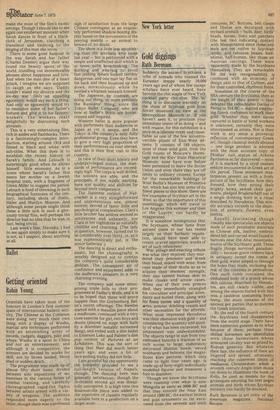New York letter
Gold diggings
Ruth Berenson
Suddenly the ancient Scythians, a tribe of nomads who roamed the Eurasian steppe nearly 10,000 years ago and of whom few except scholars have ever heard, have become the chic staple of New York cocktail party chit-chat. The 'in' thing is to discourse learnedly on the show of Scythian gold from Soviet museums on view at the Metropolitan Museum or, if you haven't seen it, to proclaim your immediate intent of so doing — and with reason, for this exhibition is a once-in-a-lifetime event and classifiable as one of the few incontrovertible pluses of East-West detente. It consists of 180 objects, most of them solid gold, from the Gold rooms of Moscow's Hermitage and the Kiev State Historical Museum; none have ever before been permitted to leave the Soviet Union and even there they are off limits to ordinary citizens. Except for the remarkable holdings of West Berlin's Museum of Primitive Art, which has also lent some of its finst pieces to this show, there are few examples of Scythian art in the West, so that the importance of this assemblage, which will travel to Los Angeles this summer and then to the Louvre, can hardly be exaggerated.
It is somehow incongruous that the Scythians, whose fame from ancient times to our has rested largely on their barbaric reputation, should have been able to create, or even appreciate, works of art of such refinement.
War, pillage and exacting tribute was what they enjoyed; they murdered their prisoners and drank their blood, mixed with wine, from cups made of their skulls so as to acquire their enemies' strength; they also tanned human skin to make cloaks and arrow cases. When one of their own princes died, they immediately strangled his concubine and principal attendants and buried them, along with his finest horses and a quantity of arms, armour, drinking vessels and other necessities for the afterlife, What most impressed Herodotus was their obsession with gold — and considering the quantity and quality of what has been excavated, his amazement was understandable. The objects range in size from tiny embossed buttons a fraction of an inch across to large, elaborately decorated libation bowls, sword scabbards and helmets; the magnificent Kiev pectoral, which only came to light four years ago, is made up of forty-eight individually modelled figures and measures a foot in diameter.
Though we know the Scythians were roaming over what is now Mongolia as early as 3000 BC and that they entered the Near East around 1000 BC, the earliest bronze and gold ornaments so far excavated from the seventh and sixth centuries, BC. Buttons, belt clasps and fibulae are decorated with stylised animals — bulls, deer, birds' heads, horses, lions and panthers (the last two indicating contact with Mesopotamia since these animals are not native to Scythian lands), and fabulous beasts, halfanimal, half-human, like those on Assyrian carvings. These were apparently made by the Scythians themselves. They are remarkable for the way recognisability is combined with an economy of design akin to that of Cubism, and for their controlled, rhythmic force.
Sometime in the course of the fifth century the Scythians, then at the height of their power — they defeated the redoubtable Darius of Persia in 514 BC — started employing Greek craftsmen to work their gold. Whether they were slaves captured in battle or hired workers is unknown; certainly they were unsurpassed as artists. Nor is their work in any sense a provincial reflection of contemporary Greek art; though classical motifs abound — one large pendant is adorned with the most accurate copy of Phidias' cult statue of Athena Parthenos so far discovered — most of it is marked by a vivid realism seldom encountered in Greek art of the period. These miniature masterpieces present us with a lively picture of the Scythians: how they dressed, how they strung their mighty bows, sewed their garments, pledged Bruderschaft out of a single drinking horn in a ritual described by Herodotus. This minute accuracy extends to the depiction of animals, flowers, even insects. _
Equally fascinating though visually less spectacular are objects made of such perishable materials as Chinese silk, leather, embroidered felt and carved wood found in barrows near the Altai mountains, source of the Scythians' gold. These fragile things survived paradoxically — because grave robbers back in antiquity looted. the tombs of their gold; water seeped in through the holes they made, enclosing the rest of the contents in permafrost. One such tomb contained the embalmed body of a prince whose skin tattoos, described by Herodotus, are still clearly visible; and among the objects buried with him was a cauldron containing burnt hemp, the mute remains of the ancient pot parties that so puzzled the Greek historian.
By the end of the fourth century the Scythians had disappeared from the world stage. There have been numerous guesses as to what became of them; perhaps these skilled horsemen are identifiable with those Sarmatians whose armoured cavalry was so prized by Roman generals. But whatever their fate, the influence of their art lingered and spread, ultimately reaching the outermost limits of mediaeval Christendom: when a seventh century Anglo-Irish monk sat down to illuminate the book of Kelis, he used as models for the grotesques adorning his text pages animals and birds whose Scythian ancestry can hardly be doubted.
Ruth Berenson is art critic of the American magazine, National Review


































 Previous page
Previous page